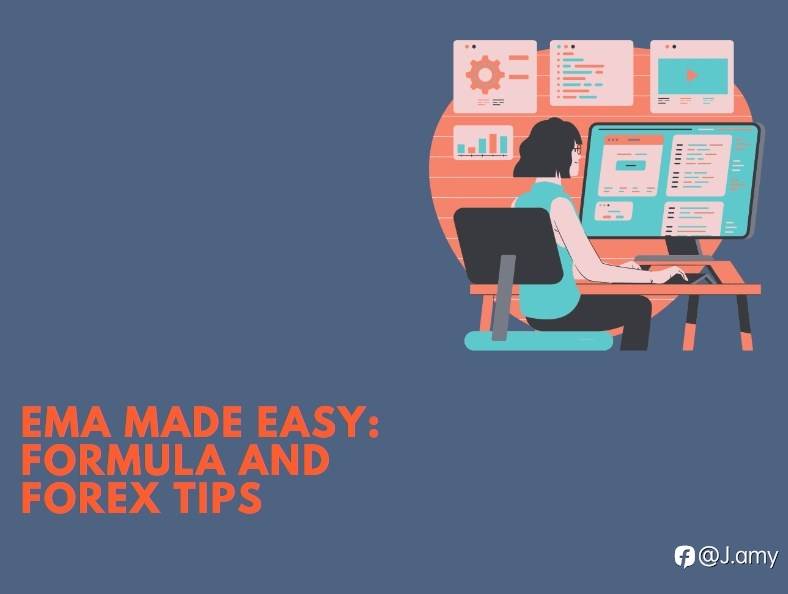The world of Forex trading is dynamic and challenging, demanding a deep understanding of various technical indicators to make informed decisions. Among these indicators, the Exponential Moving Average (EMA) stands out as a versatile tool that helps traders identify trends, potential reversals, and optimal entry and exit points. In this article, we will break down the EMA formula, explore its advantages, and provide practical tips for incorporating it into your Forex trading strategy.

Understanding EMA - The Basics
The Exponential Moving Average is a type of moving average that assigns greater weight to recent price data, making it more responsive to current market conditions. Unlike the Simple Moving Average (SMA), which treats all data points equally, the EMA reacts more quickly to price changes, making it a preferred choice for traders looking for timely signals.
EMA Formula:
EMA = (Closing Price - EMA(previous day)) Multiplier + EMA(previous day)
- Closing Price: The price of an asset at the end of the selected period.
- EMA (previous day): The EMA value for the previous day.
- Multiplier: A smoothing factor calculated based on the length of the EMA period. It is usually calculated as 2 / (N + 1), where N is the number of days in the EMA period.
Advantages of EMA in Forex Trading
Timely Trend Identification: The EMA reacts quickly to price changes, enabling traders to spot trend reversals and new trends early. This responsiveness is especially valuable in fast-moving markets.
Reduced Lag: Compared to the SMA, the EMA has less lag, meaning it closely tracks price movements, providing more accurate signals for entry and exit points.
Versatility: EMA can be applied to various timeframes, from short-term scalping to long-term investing, making it adaptable to different trading styles.
Support and Resistance: EMA values can act as dynamic support or resistance levels, helping traders identify critical price zones for potential reversals.
Practical Tips for Using EMA in Forex Trading

Selecting the Right EMA Period
Choosing the appropriate EMA period is crucial. Shorter periods (e.g., 5, 10, or 20) are more sensitive to price changes and provide signals for short-term trading. Longer periods (e.g., 50, 100, or 200) are better suited for identifying long-term trends. Experiment with different periods to find the one that aligns with your trading strategy.
Combining EMAs
Some traders use multiple EMAs with different periods to create a "crossover" strategy. For instance, a common approach involves using a shorter EMA (e.g., 10) and a longer EMA (e.g., 50). When the shorter EMA crosses above the longer one, it generates a bullish signal, and vice versa for bearish signals.
Confirming with Other Indicators
EMA signals can be reinforced by combining them with other technical indicators such as Relative Strength Index (RSI), Moving Average Convergence Divergence (MACD), or Fibonacci retracement levels. This helps reduce false signals and enhances overall trading accuracy.
Risk Management
No trading strategy is foolproof, and risk management is paramount. Use stop-loss orders to limit potential losses and take-profit orders to secure profits. Ensure that your risk-to-reward ratio is reasonable for each trade.
Backtesting and Practice
Before implementing the EMA strategy with real capital, conduct thorough backtesting using historical data. This will help you understand how the strategy would have performed in different market conditions. Additionally, practice with a demo account to gain confidence and refine your execution.
Stay Informed
Stay updated on economic events, news releases, and global developments that can impact the Forex market. Sudden news can lead to price gaps that might not align with your EMA-based predictions.
EMA in Action - A Practical Example
Let's illustrate how the EMA can be applied in a real-world Forex trading scenario:
Scenario: You are a swing trader using daily charts to identify trends in the EUR/USD currency pair.
Select EMA Period: You decide to use a 50-day EMA and a 200-day EMA.
Signal: The 50-day EMA crosses above the 200-day EMA, indicating a potential bullish trend.
Entry: You enter a long position when this crossover occurs.
Stop-Loss: You place a stop-loss order just below the recent swing low to limit potential losses.
Take-Profit: You set a take-profit order at a predetermined level or based on your risk-reward ratio.
Monitor and Adjust: Continuously monitor the trade, adjusting stop-loss and take-profit levels as the market moves in your favor.
Conclusion
The Exponential Moving Average is a powerful technical indicator in the world of Forex trading, offering traders a flexible tool for trend identification and signal generation. By understanding the EMA formula, its advantages, and practical tips for implementation, traders can incorporate this indicator into their strategies to make more informed and timely trading decisions.
Remember that while the EMA can be a valuable asset in your trading toolbox, it should be used in conjunction with other indicators and a well-defined risk management plan. Continuous learning, practice, and adaptability are key to becoming a successful Forex trader using the EMA as a guiding compass in the dynamic world of currency markets.
More:TRAND LINE & 50 EMA
风险提示:以上内容仅代表作者或嘉宾的观点,不代表 FOLLOWME 的任何观点及立场,且不代表 FOLLOWME 同意其说法或描述,也不构成任何投资建议。对于访问者根据 FOLLOWME 社区提供的信息所做出的一切行为,除非另有明确的书面承诺文件,否则本社区不承担任何形式的责任。
FOLLOWME 交易社区网址: followme.asia


加载失败()